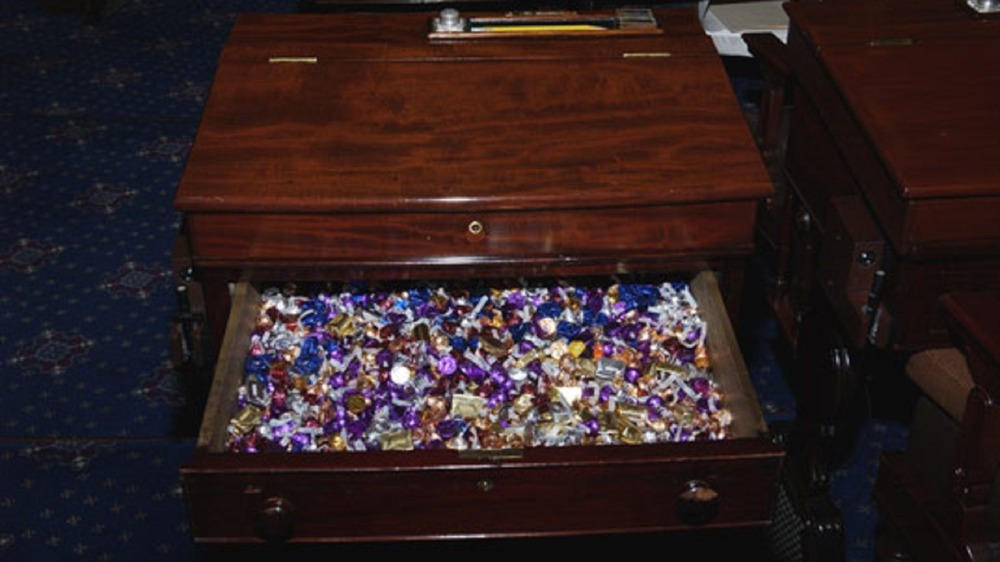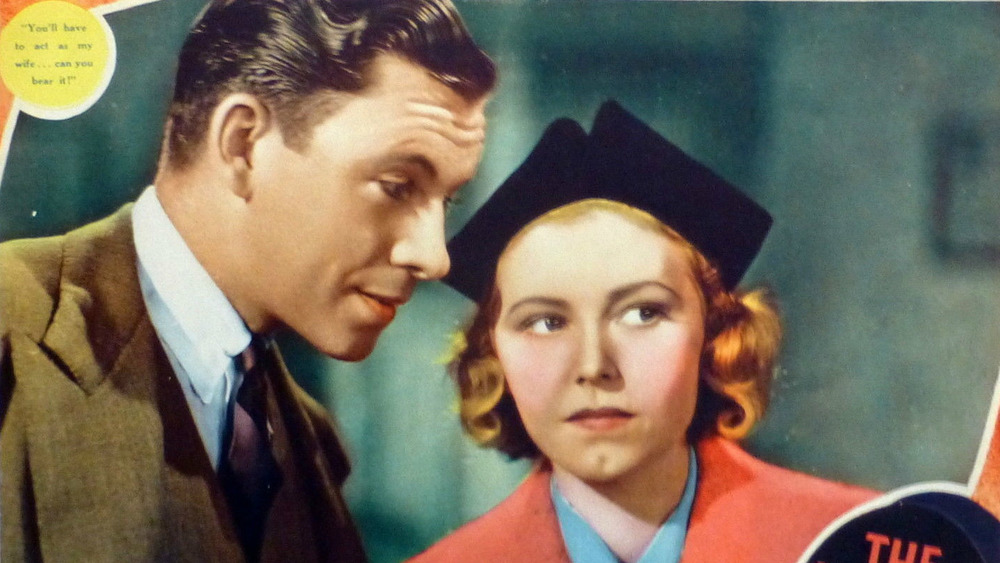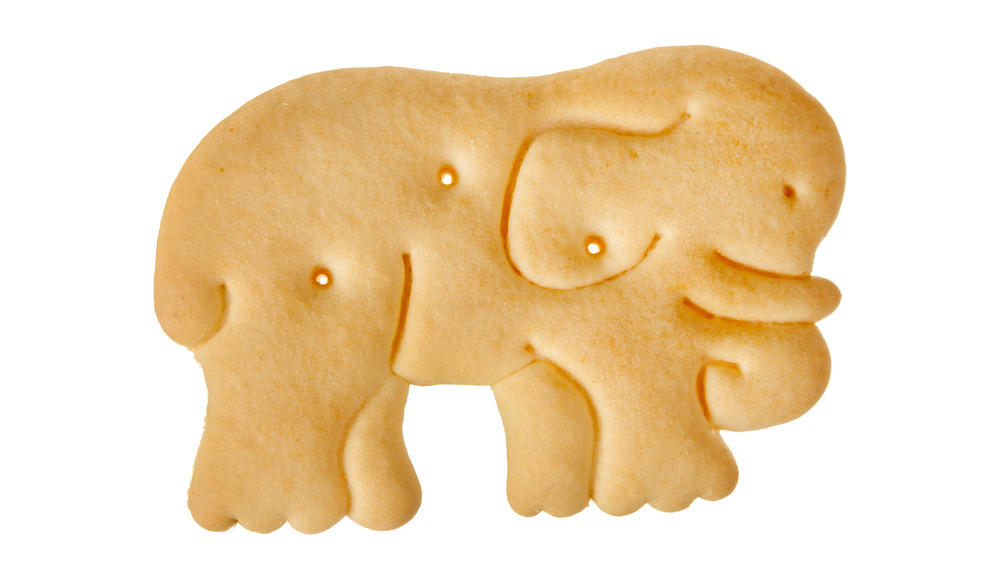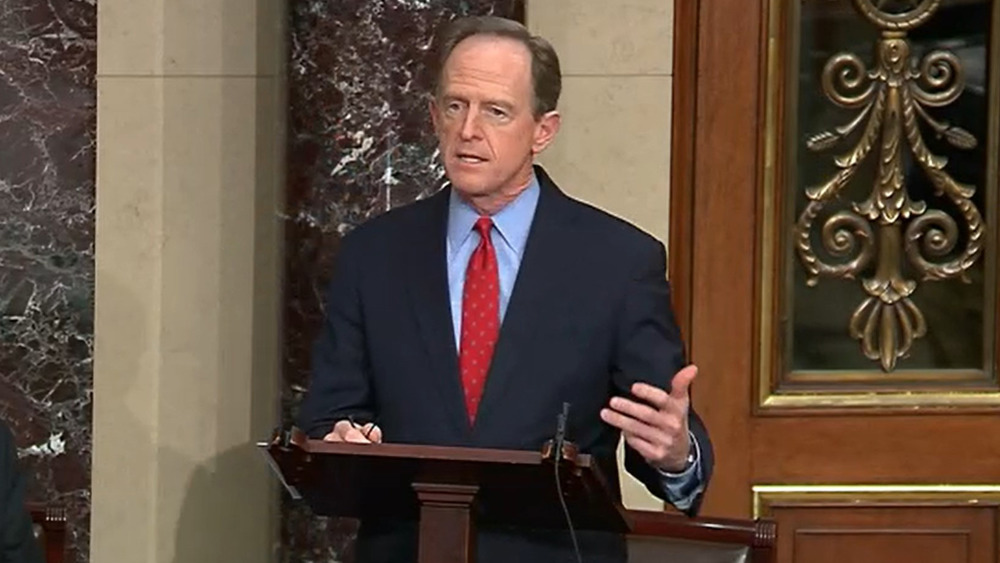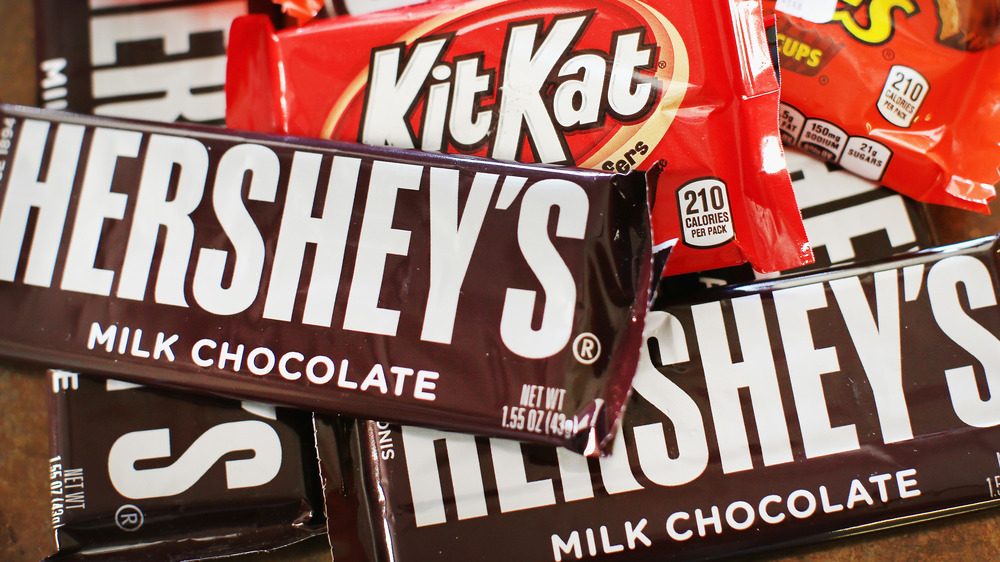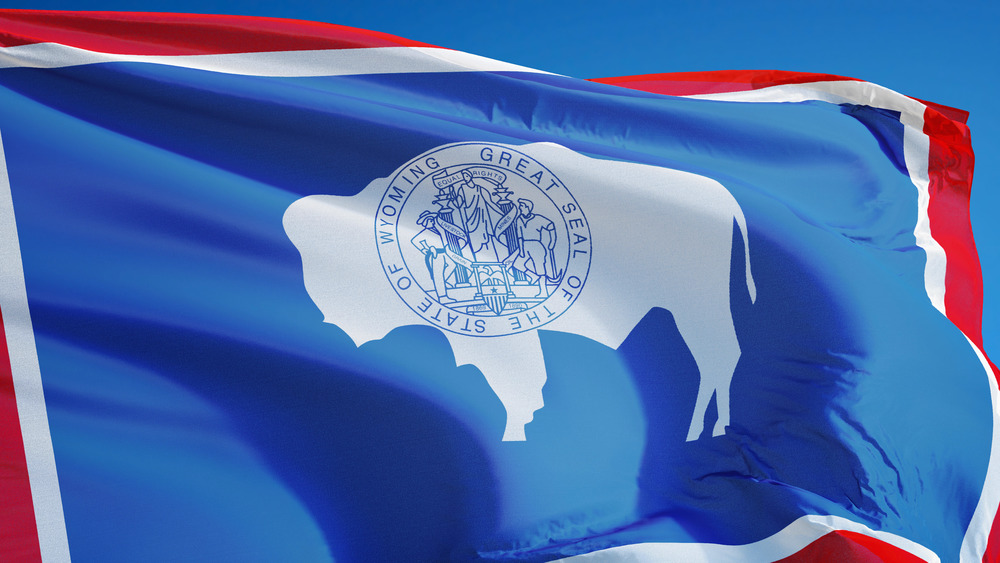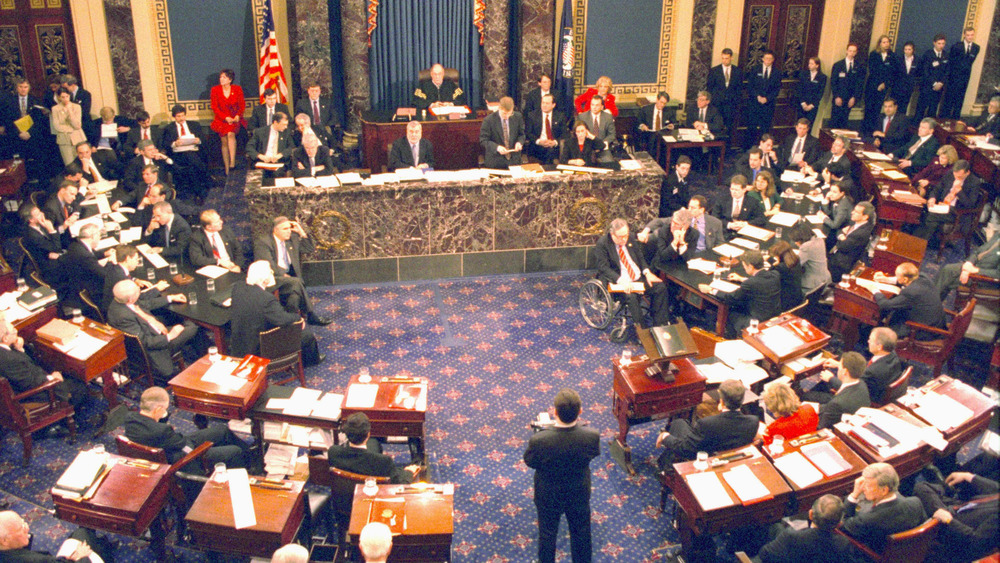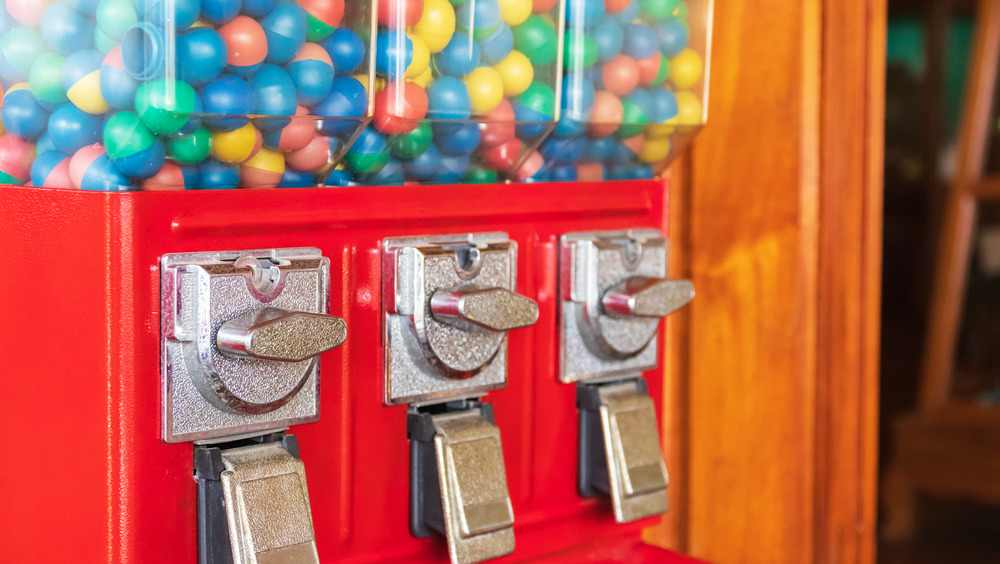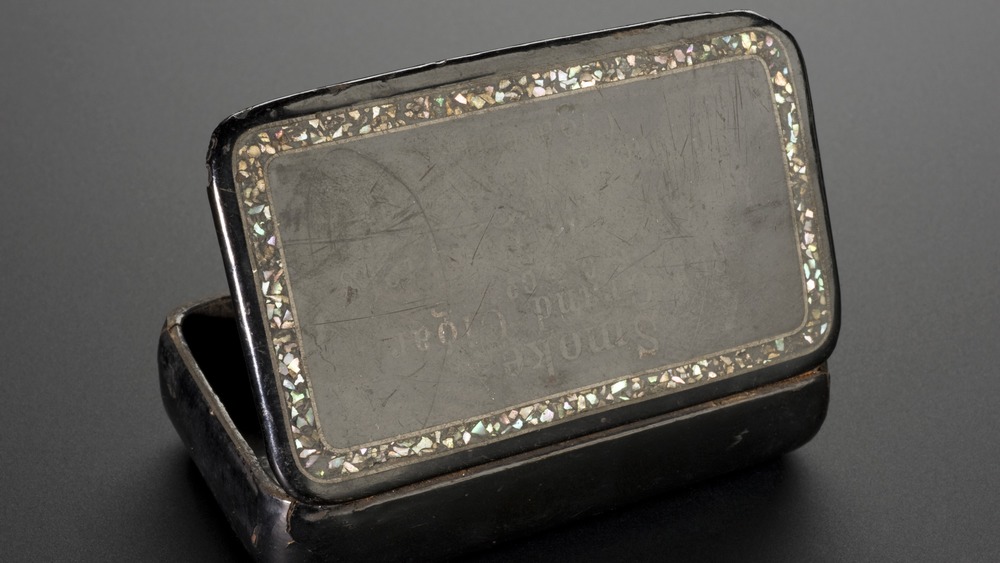The Untold Truth Of The Senate Candy Desk
Almost every office has a spot where people gather together and share food. Sometimes you might find freshly baked cookies or a box of Munchkins from the local Dunkin' in these spots, but most of the time the snack being shared is candy. It might be bite-sized candy bars, hard fruit-flavored discs, cinnamon drops, M&M's, or jelly beans. Whatever candy it is that's being offered, if you're lucky, the keeper of that communal candy bowl ensures it is always well-stocked so you always know where to go when you need that 3:00 p.m. sugar jolt.
Turns out the U.S. Senate chamber in our nation's capital is just like your office, as Senators can munch on free candy all day, too. Only, instead of grabbing their candy from a candy bowl, they have a fabled "candy desk" with a long and storied past going back more than 50 years.
And just like the candy bowls we all know from our own workplaces, it's in a high traffic area and always packed full of candy that's free for the taking. Whether Senators are listening to hour-long hearings, passing time during filibusters, or sweating the fate of the nation in impeachment hearings, the Senate candy desk is always the go-to spot for a quick burst of sugar powered energy.
The Senate candy desk started with California Senator George Murphy
As with most workplace candy purveyors, the person behind the original Senate candy desk had a hardcore sweet tooth. In this case, that individual was Senator George Murphy, a California Republican and former president of the Screen Actors Guild (via The New York Times).
According to the United States Senate, in the early years of his term, Murphy was well known for always keeping an abundant stash of candy on his desk when the Senate was in session. He gradually started sharing that candy with his co-workers and, before long, a tradition was established.
In 1968, the spot where Murphy was assigned to sit changed. He was moved to a desk in the back of the Senate chamber, close to an exit. With the continual traffic of Senators walking back and forth past Murphy's desk, always grabbing a piece of candy on their way, his candy supply took a severe hit. Murphy realized that he needed to increase his reserves significantly in order to meet the newfound demand. He invited other Senators to contribute to the desk's reserves as well.
Unable to keep enough candy on top of his desk to satisfy 100 hungry Senators, Murphy moved his supply into one of the large drawers on his massive mahogany desk. Thus, the Senate candy desk was born.
Before he ran the Senate candy desk, Murphy was a Hollywood actor
George Murphy was born in Connecticut in 1902, according to his Senate biography. Although he was highly competitive, he was never a good student. Murphy gained a Yale scholarship in 1921 but left college to tackle a variety of jobs. including coal mining and working as a Wall Street messenger. In 1926, Murphy wed a New York City actress and the two turned their focus to performing, becoming a successful vaudeville and Broadway act.
Feeling they'd conquered New York, the couple moved to Hollywood and began appearing in movies. Murphy starred in more than 40 films in dramatic roles and as a lighthearted musical lead. Murphy was also a die-hard political junkie. In 1939 he co-founded the Hollywood Republican Committee along with superstars Fred Astaire and Ginger Rogers.
Conservative politics became more and more appealing to Murphy as he got older. He led conservative circles in the city and encouraged up-and-coming actor and future president Ronald Reagan to focus on politics. In 1952, Murphy quit acting and moved to politics permanently. "He directed the inaugurations of President Dwight Eisenhower, provided programming for four national party conventions, and served as the party's principal fundraiser," reports his Senate history. In 1965, he was elected to the U.S. Senate, where he served a single term. Murphy made a number of contributions during his time in Congress, but perhaps none were so lasting as Murphy's creation of the Senate candy desk.
The Senate candy desk will likely always be Republican
Following California Senator George Murphy's exit from the Senate in 1971, the Senate candy desk has been occupied by 17 other senators, according to the Architect of the Capitol. Many of them have only stayed at the desk, marked number 80 on the Senate floor plan, for a few years. But while the senators sitting at the desk may have come and gone, the drawer itself has never stopped being fully stocked with candy.
Located on the Republican side of the Senate chamber, in the last row, on the aisle, and adjacent to a bank of heavily-used elevators, the two-century-old mahogany desk containing the Senate candy drawer is directly in front of one of the room's most heavily used entrances and near a popular bank of elevators (via Food & Wine).
While it was started by a Republican in a constantly shifting Congress, the candy desk will likely always be controlled by Republicans as well. That's not because Democrats don't like candy, according to DCist, but rather due to the way seating is organized within the Capitol. Democrats are always seated on the left side of the chamber and move inwards. Republicans are seated on the right side and their members likewise move towards the center of the room as more seats are assigned to their party. "Democrats would need to win the largest majority since Reconstruction—80 seats—to take over the candy desk," DCist reports.
Senator Pat Toomey is the current keeper of the Senate candy desk
Following notable stays from senators such as John McCain, Bob Bennett, Slade Gorton, and Rick Santorum, who all had a brief reign over the Senate candy desk, Pennsylvania Republican Patrick J. Toomey has been the keeper of the Congressional candy since 2015. In a pun-filled press release announcing he would soon be sitting at the desk where the candy drawer is located, Toomey and his team wrote about the senator's plans to continue fighting against the deficit. That is, the candy deficit.
"The Candy Desk duty is Mounds of responsibility," Toomey's release began. "I campaigned for this assignment on the platform of life, liberty, and the pursuit of Peeps and hope Pennsylvania's treats will sweeten the bitter partisan atmosphere." He then added that "I plan to stock the Candy Desk with Pennsylvania's finest chocolate and deliciousness to ensure a surplus of sweets."
In an interview with The New York Times, Steve Kelly, a spokesman for Toomey, told the paper the popular and well thought of senator planned to be fair and inclusive in his distribution of sweets, claiming that it was open to all Senators regardless of their political affiliation. Today, all Senators, from Republicans to Democrats, to Independents, are welcome to stop by the candy desk.
The Senate candy desk is always filled with a selection of candy from a senator's home state
One rule for Senate behavior has held true ever since the Senate candy desk was created. According to Senate ethics guidelines, senators are unable to accept more than $100 worth of gifts from any single donor in a given year. The one exception to this, as the Pittsburgh Post-Gazette has pointed out, is that senators are free to accept gifts of consumable commodities such as food, as long as the items are of minimal value, are shared, and come from a senator's home states. Meaning, if you are sitting at the Senate candy desk and you are a senator from Pennsylvania, home to the Hershey's chocolate empire, you're free to accept all the candy Hershey's cares to send you, as long as you share the spoils.
Because of this, Senator Pat Toomey has one of the best-stocked candy drawers in Senate history. The New York Times has reported that his free candy offerings include Hershey's bars, 3 Musketeers, Milky Ways, and more. Working for a state at the center of one of America's biggest candy empires has its perks.
Prior to Toomey's tenure at the Senate candy desk, Illinois Senator Mark Kirk also kept a well-appointed candy drawer that any sugar junkie would be proud of. His offerings in the desk's drawer during his time there included Jelly Belly jelly beans, Snickers bars, gummy bears, and Hubba Bubba bubblegum (via Pittsburg Post-Gazette).
Candy is the only food allowed on the Senate floor
While most of us live on coffee and an occasional hit of fast food at our desks, especially when working, the Senate is far more strict about what lawmakers can eat at their desks while the chamber is in session. The permitted food and drink, according to The New York Times, includes water, candy, and milk. That's it, seriously.
Candy is allowed because of the tradition Senator George Murphy started back in the 1960s. Oddly enough, that's also when milk became permissible on the floor. Vice reports that milk was allowed in 1966 after Senator Everett Dirksen of Illinois requested a tall glass of the white stuff, proclaiming that "water becomes pretty thin after a period of time."
While it sounds like a usual request, especially for something that has since become part of Senate procedure, doctor and Senator Bill Cassidy of Louisiana told CNN there was likely another reason milk was permitted on the floor. He explained that treatment options for conditions like ulcers were limited at the time. Milk was possibly allowed as a means for senators to ease their upset stomachs, though modern lawmakers may want to consider coconut milk as an ulcer treatment instead.
Of course, when hunger strikes or a senator really needs coffee or some other food not allowed on the floor, they can also always sneak off for a snack in the nearby cloakroom (via CNBC).
The Senate candy desk almost ran dry once
In January of 2007, beloved Wyoming Senator Craig Thomas took over the Senate candy desk. Unfortunately for the senators with whom he was serving, the sparsely populated Western state of Wyoming is not exactly a mecca for industry, let alone candy production. Senator Thomas found that he had no major candy suppliers from Wyoming on call to help him stock the Senate candy desk.
Pundits were concerned the Senate candy drawer tradition may end if Senator Thomas couldn't find a way to keep the sugar coming in for his co-workers in the Senate. According to The Missoulian, a local Wyoming-based company that made chocolate-covered popcorn volunteered to donate some of their products to the senator's desk, in an attempt to bring an end to the impending candy crisis. However, the discussion on how the problem presented by Wyoming's lack of candy producers would be solved never progressed further than that. Turns out, the Senate already had a bounty of candy stored and on hand from outgoing Senator Rick Santorum. Santorum, like his fellow senator and previous candy desk guardian Senator Pat Toomey, hails from the candy-rich state of Pennsylvania.
Sadly, Senator Thomas wasn't at the Senate candy desk for long. Having been previously diagnosed with leukemia and undergoing treatment for the disease, The New York Times reported that the three-term senator passed away from his illness in the summer of 2007, mere months after he took office.
The Senate candy desk is a big deal during impeachment hearings
During the impeachment trials of President Clinton in 1999 and President Trump in 2020, the workdays for senators seemed endless. With all "real" food prohibited from the Senate floor, the Senate candy desk was all that many officials had to keep them going. "The candy desk is actually a very important part of keeping senators awake during these long hours of testimony," former Senator Rick Santorum told NPR, recounting the 1999 impeachment of President Clinton. "Having a little energy boost as you're sitting there at the desk is sometimes a good thing."
Senator Santorum, who also ran for President in 2012 and 2016, occupied the Senate candy desk during the Clinton impeachment, during which time he offered Senators a selection of Pennsylvania chocolate, Hot Tamales, and Peeps. In a 2020 interview with local Allentown, Pennsylvania newspaper The Morning Call, he recounted that during the Clinton impeachment, it wasn't just senators who were getting daily candy from his desk. Santorum said that his staff made sure "the House Republicans arguing the case for impeachment also had a candy stash in the Capitol room they used to prepare each day."
When Charles Ruff, a defense lawyer for the president, joked with Santorum about the unfair advantage of lawyers from the opposite team having so much free candy, Santorum made sure Clinton's defenders were also well-stocked with candy for the remainder of the impeachment hearing.
Democrats have their own self-funded alternative to the Senate candy desk
Although Republicans have always claimed the Senate candy drawer is available for Senators and staff of any political party, Democrats have maintained their own competing candy drawer since at least 1985, according to AV Club. Whether it's because they don't like the selection of sweets in the more well known Republican candy desk, it's too far out of the way (being on the opposite side of the chamber and all), or the Republicans just aren't good at sharing, the Democratic version of the "office candy bowl" persists to this day.
However, instead of being stocked with samples of free candy from a senator's home state, Democrats chip in and buy their own candy. This allows them to stock up on personal favorites, as well as new and more trendy candy options. Though they pay for it, Democrats can procure a steady supply of whatever sweets they want.
"The Democratic desk belongs to whichever senator is the party's Conference Secretary," AV Club reported, noting that this is the party's fourth-ranked position in the U.S. Senate.
While the Democratic "owner" of the competing Senate candy desk varies, recently it was the responsibility of West Virginia Senator Jay Rockefeller, according to the Pittsburgh Post-Gazette. Since the time the Democratic candy desk tradition began, Rockefeller took up buying candy in bulk for the desk, along with collecting money from Senators who chipped in for its purchase.
The U.K. Parliament has their own version of a candy desk filled with tobacco
While U.S. Senators are blessed with free candy, members of U.K. Parliament have the opportunity to enjoy a more questionable freebie. Directly inside a private entrance to the House of Commons in what The Parliamentary Review has described as a "wooden box, adorned with a metal plate listing the names of every doorkeeper who has held the post for the last seventy years" is the Parliamentary snuff box.
That's right: UK legislators have a free and government-sanctioned supply of snuff. For the uninitiated, snuff is a "smokeless tobacco that is sniffed or snorted, providing a direct nicotine hit and a lasting scent," says The Parliamentary Review. Meanwhile, smoking has not been allowed within the House of Commons since the 17th century.
The BBC has reported that the tiny box, made from wood reclaimed after the original House of Commons was destroyed in World War II, first came into existence in 1884 as a way to "offer a performance-enhancing pick-me-up for crucial Commons tests of mettle... or chemical consolation for those found wanting."
Although the box is still filled with free snuff even today, it's more symbolic than of actual use to members of Parliament. House of Commons officials told the BBC no documented snuff had been taken from the box in more than 30 years.

